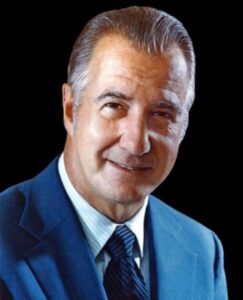Spiro Agnew whose full name is Spiro Theodore Agnew was The 39th vice president of the United States, who held office from 1969 until his resignation in 1973. John C. Calhoun left his post as vice president in 1832, making him the second vice president to do so.
Agnew is renowned for his swift political ascent, moving from County Executive to Vice President in just six years. Gerald Ford, who had been Nixon’s vice president, took over as president after his resignation, becoming the first non-elected leader of the country in its history.
He is an ardent opponent of communism and a staunch advocate of American engagement in Vietnam rose to political prominence quickly and then fell into oblivion almost as quickly.
Read Also: Joe Lewis Biography: Yacht, Wife, Daughter, and Net Worth
Biography of Spiro Agnew
Spiro Agnew was born on November 9, 1918, in Baltimore, Maryland, to an American mother and a Greek immigrant father. His full name is Spiro Theodore Agnew, often known as Spiro T. Agnew.
Instead of being baptized into his father’s Greek Orthodox Church, Spiro was christened as an Episcopalian in line with his mother’s desires. However, Agnew Senior was the head of the household and a big influence on his son.
The Greek community of Baltimore established a scholarship in Theodore Agnew’s honor in 1969, and Spiro Agnew addressed the group when it did so: “I’m pleased to report that I was raised in my father’s shadow. He shares my values.”
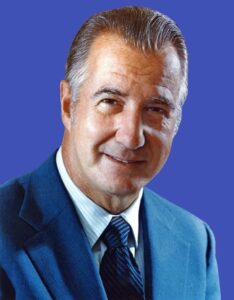
Agnew enrolled at the Johns Hopkins University’s brand-new Homewood campus in north Baltimore in February 1937 as a chemistry major. After a few months, the stress of the academic work became too much for him to handle, and he became preoccupied with his family’s ongoing financial issues and concerns about the impending conflict in the world.
He left Johns Hopkins in 1939 and enrolled in night sessions at the University of Baltimore School of Law after deciding that law rather than chemistry was what he should study in the future.
He started working as an insurance clerk during the day at the Maryland Casualty Company’s “Rotunda” facility on 40th Street in Roland Park in order to support himself. Agnew worked for the corporation for three years, rising to the level of the assistant underwriter. At the workplace, he met Elinor Judefind, also known as “Judy,” a teenage file clerk.
Agnew and she shared the same neighborhood in which they were raised, but they had never met before. They started dating, got engaged, and got married on May 27, 1942, all in Baltimore. Pamela Lee, James Rand, Susan Scott, and Elinor Kimberly were their four children.
He was appointed in 1962 to serve as Baltimore County Executive. In order to become governor of Maryland in 1966, Agnew beat Democratic rival George P. Mahoney and Independent candidate Hyman A. Pressman.
Richard Nixon requested Agnew to submit his name for candidacy and chose him as his running mate at the 1968 Republican National Convention. Nixon was drawn to Agnew’s image as a moderate, and advisers like Pat Buchanan liked the law-and-order approach he had adopted in the aftermath of the turmoil that year.
Although Agnew made a number of mistakes throughout the campaign, many Republicans were happy with his rhetoric, and he may have been the deciding factor in a number of crucial states. Nixon and Agnew beat the Democratic ticket of outgoing Vice President Hubert Humphrey with Senator Edmund Muskie as his running partner.
Agnew frequently had to take on the adversaries of the government in his capacity as vice president. Agnew went to the right while serving as vice president, winning over conservatives who were wary of Nixon’s moderate policies. In one of the biggest landslides in American history, Nixon and Agnew defeated Senator George McGovern and his running mate Sargent Shriver to win re-election for a second term as president in 1972. Visit Wikipedia to learn more.
Read Still: Sir Michael Hopkins: An English Architect and Material Exploration Pioneer
Spiro Agnew Political Career
In 1956, Agnew ran as a Republican for Baltimore County Council, making it his first run for elective office. Despite the fact that he was rejected by the local party officials, he fiercely ran for the Republican nomination.
The surprise Republican majority on the council was a result of the election, and Agnew was appointed for a one-year term to the county Zoning Board of Appeals at a salary of $3,600 year in appreciation for his party efforts.
Agnew appreciated the grandeur that came with the appointment and saw this quasi-judicial position as a valuable addition to his law business. He was reappointed to the Board in April 1958 for another full three-year term, this time as its chairman.
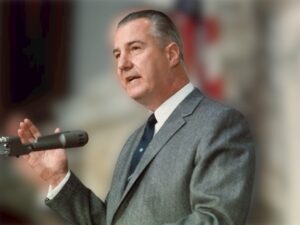
Agnew made the decision to run for the county circuit court in the November 1960 elections, going against the regional custom that incumbent judges seeking reelection were not contested. Out of five contenders, he came in last place and failed. His profile was increased by this failed endeavor, and his Democratic rivals saw him as a rising Republican.
After the Democrats won control of the county council in the 1960 elections, one of their first moves was to oust Agnew from the Zoning Appeals Board. “The publicity produced by the Democrats’ brutal dismissal of Agnew presented him as the honest servant mistreated by the machine,” writes Agnew’s biographer Jules Witcover.
In an effort to take advantage of this atmosphere, Agnew requested to be nominated as the Republican candidate for Maryland’s 2nd congressional district in the 1962 U.S. Congressional elections. Despite wanting to capitalize on Agnew’s local popularity, the party went with the more qualified J. Fife Symington.
He agreed to compete for the county’s top executive position the county executive which the Democrats had controlled since 1895. When retired former county executive Michael Birmingham and his replacement fell out and Birmingham lost the Democratic primary, Agnew’s prospects of winning were improved.
Agnew was able to run for office as a “White Knight” promising change in contrast to his elderly rival; his platform included an anti-discrimination law requiring public places like parks, bars, and restaurants to be open to people of all races, which neither Birmingham nor any Maryland Democrat could have introduced at the time without upsetting supporters.
In the November election, Agnew defeated his rival by 78,487 votes to 60,993, despite the vice president’s intervention on favor of Birmingham. Agnew rose to become the highest-ranking Republican in Maryland after Symington’s defeat to Clarence Long in the battle for the Maryland congressional seat.
Read-Along: Thomas Ballatore Actor, Awards, Birth, Net Worth, Filmography
Spiro Agnew Legacy | Controversy
Agnew’s legacy was widely viewed negatively at the time of his passing. His circumstances of leaving public life, especially in light of his stated commitment to law and order, contributed significantly to the cynicism and mistrust that exists toward politicians of all stripes.
His scandal made people choose possible vice presidents with more caution. The majority of the running mates chosen by the major parties following 1972 were seasoned politicians, including Walter Mondale, George H. W. Bush, Lloyd Bentsen, Al Gore, Jack Kemp, Joe Lieberman, Dick Cheney, and Joe Biden, some of whom went on to become their party’s presidential contender.
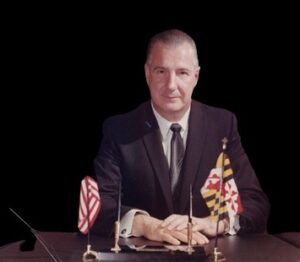
Victor Gold, Agnew’s former press secretary, referred to him as the movement’s “John the Baptist.” Some contemporary historians have argued that Agnew should be remembered with the New Right’s other well-known founding fathers, like Goldwater and Reagan.
When Johnsonian liberalism was at its height in 1964, Goldwater’s campaign was too soon. However, by the time Agnew was elected, liberalism had begun to decline, and as Agnew went to the right in 1968, the nation followed suit. Although Agnew’s downfall startled and devastated conservatives, it had little effect on the New Right’s expansion.
Agnew, the first suburban politician to hold a high office, contributed to the spread of the idea that elitists and effete liberals dominated a large portion of the national media. Agnew “helped remake the Republicans as a Party of ‘Middle Americans,'” according to Levy, and “even in disgrace, reinforced the public’s mistrust of government.”
Although Agnew came from humble beginnings in Baltimore and is now the next-in-line for the president, “As the first Vice President of the United States to resign in disgrace, there was little question that he had already been judged by history. Everything he accomplished or tried to do in his public life was subsumed by that sad and unreputable conduct “.
According to Levy, Agnew’s career “could have been” as follows:
- It is not a stretch to think that today we might be speaking of Agnew-Democrats and Agnewnomics and deeming Agnew the father of modern conservatism if Agnew had contested corruption charges half as vehemently as Nixon denied responsibility for Watergate. Goldwater and several other steadfast conservatives wanted Agnew to do this.
Spiro Agnew Death | Memory
Agnew avoided the press and political scene in Washington for the rest of his life. He said he felt “completely abandoned” and refused to answer any of President Nixon’s calls. Agnew was invited to the funeral in Yorba Linda, California when Nixon passed away in 1994 by his daughters.
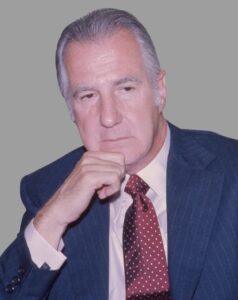
He first turned down the offer because he was still resentful of how the White House had treated him during his final days as vice president. Over the years, he had also turned down several attempts by the Nixon camp to heal their differences.
He was convinced to accept the offer, and when he arrived, his former coworkers gave him a warm welcome. “I chose to put it aside after twenty years of bitterness,” he remarked. A year later, Agnew showed up in Washington, D.C., for the dedication of a bust honoring him that would stand among those of past vice presidents.
Agnew stated: “I’m neither deaf nor ignorant to the reality that some individuals believe the Senate is bestowing upon me an honor I don’t deserve by ordering this bust. I would like to remind these individuals that this event is more about the office I held than it is about Spiro Agnew “.
Agnew passed out at his vacation home in Ocean City, Maryland, on September 16, 1996. He was brought to Atlantic General Hospital, where he passed away the same night. Untreated acute leukemia was the cause of death. Agnew played tennis and golf frequently and stayed in shape well into his seventies. On the day of his passing, he planned to play tennis with a buddy.
Mostly only family members attended the funeral in Timonium, Maryland; Buchanan and several members of Agnew’s old Secret Service detail also went to pay their respects. A joint military honor guard fired a 21-gun salute at the burial in remembrance of his tenure as vice president.
Read More: Latest Biography updates of Celebrities, artists, actresses, Politicians, and More
John Harington Inventions, Biography, School, Wife, Birth, and Death
Jack Absalom Art: An Australian Artist, Author, and Adventurer
